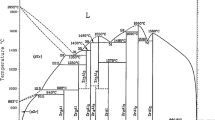Abstract
The Mo-Zr system was critically assessed using the calculation of phase diagrams (CALPHAD) technique. The solution phases (liquid, bcc, and cph) were modeled with the Redlich-Kister expression for the excess Gibbs energy. The intermetallic Mo2Zr Laves phase, which has a measurable homogeneity range, was treated by a two-sublattice model with Mo and Zr on both sublattices. A set of self-consistent thermodynamic parameters for the Mo-Zr system was obtained. With the optimized functions for the Gibbs energy of the individual phases, most of the experimental information can be well reproduced.
Similar content being viewed by others
References
J.L. Ham: “An Introduction to Arc-Cast Molybdenum and Its Alloys,” Trans. ASME, 1951, 73, pp. 723–32.
R.F. Domagala, D.J. McPherson, and M. Hansen: “Systems Zirconium-Molybdenum and Zirconium-Wolfram,” Trans. Met. Soc. AIME, 1953, 197, pp. 73–79.
E. Pipitz and R. Kieffer: “Einfluss von Legierungszusätzen auf Festigkeitseigenschaften und Rekristallisation von Vakuumgesintertem Molybdan,” Z. Metallkd., 1955, 46(3), pp. 187–94 (in German).
M. Hansen and K. Anderko: Constitution of Binary Alloys, McGraw-Hill, New York, 1958.
M. Semchyshen and R.Q. Barr: “Molybdenum and Molybdenum-Containing Refractory Alloys,” AIME Metallurgical Society Conferences, Refractory Metals and Alloys, vol. 11, Interscience Publishers Inc., New York, 1961, pp. 283–317.
G. Brauer and F. Leibbrandt: “Reaktion von Zirkonium-Molybdän Legierungen mit Wasserstoff und mit Stickstoff,” Plansee Proceedings 1964, Metallwerk Plansee AG, Reutte/Tirol, Austria 1965, pp. 340–50 (in German).
V.N. Svechnikov and A.C. Spektor: Phase Transformations, Nauk. dumka, Kiev, USSR 1967, pp. 123–28 (in Russian).
E. Rudy: “Compendium of Phase Diagram Data,” Rep. No. AFML-TR-65-2, Part V, Air Force Materials Laboratory, Wright-Patterson, AFB, OH, 1969.
A.M. Zakharov, V.G. Parshikov, and Yu.A. Belyi: “Solubility of Zirconium in Molybdenum in the Solid State,” Izvestya Vyssh. Uchebn. Zaved., Tsvetn.. Metall., 1970, 13(5), pp. 126–29 (in Russian).
V.V. Petkov and A.V. Kotsyuruba: “The Laves Phases in the Systems Zr(Fe,Co,Ni)2-Zr(Mo,W,Re)2,” Dopov. Akad. Nauk Ukrain. RSR (A), 1972, 8, pp. 750–53 (in Ukrainian).
G.V. Samsonov, S.M. Braun, and A.A. Rogozinskaya: “Some Regularities of the Influence of the Alloying Elements on the Polymorphic Transition Temperature of Zirconium,” Izvestya Vyssh. Uchebn. Zaved., Tsvetn. Metall., 1972, 15(6), pp. 118–22 (in Russian).
O. Kubaschewski and O. von Goldbeck: Zirconium: Physico-Chemical Properties of its Compounds and Alloys, O. Kubaschewski, ed., Atomic Energy Review, Special Issue No. 6, IAEA, Vienna, Austria, 1976, pp. 96–97.
S.P. Garg and R.J. Ackermann: “The High Temperature Phase Diagrams for Zirconium-Molybdenum and Hafnium-Molybdenum,” Metall. Trans. A, 1977, 8A, pp. 239–44.
H.L. Lukas, E.Th. Henig, and B. Zimmermann: “Optimization of Phase Diagrams by a Least-Squares Method Using Simultaneously Different Types of Data,” CALPHAD, 1977, 1(3), pp. 225–36.
D.O. Northwood: “The Stability of the Beta Phase in Zr-3 wt.% Mo and Zr-3 wt.% Mo-1 wt.% Al Alloys,” J. Less-Common Met., 1978, 57, pp. 231–35.
O. Kubaschewski and C.B. Alcock: Metallurgical Thermochemistry, Pergamon Press, New York, 1979, p. 55.
L. Brewer and R.H. Lamoreaux: Molybdenum: Physicochemical Properties of its Compounds and Alloys, Atomic Energy Review, Special Issue No. 7, IAEA, Vienna, Austria, 1980, pp. 344–47.
B. Sundman and J. Ågren: “A Regular Solution Model for Phases with Several Components and Sublattices Suitable for Computer Applications,” J. Phys. Chem. Solids, 1981, 42, pp. 297–301.
S.B. Prima: Diagramy Sostoyania v Materialovedenie, Nauk. dumka, Kiev, USSR 1984, pp. 30–37 (in Russian).
Binary Alloy Phase Diagrams, 2nd ed., Vol. 1, 2, and 3, T.B. Massalski, P.R. Subramanian, H. Okamoto, and L. Kacprzak, ed., ASM International, Materials Park, OH, 1990.
T. Tanaka, N.A. Gokcen and Z. Morita: “Relationship Between Partial Enthalpy of Mixing and Partial Excess Entropy of Solute Elements in Infinitely Dilute-Solutions of Liquid Binary Alloys,” Z. Metallkd., 1990, 81, pp. 349–53.
A.T. Dinsdale: “SGTE Data for Pure Elements,” CALPHAD, 1991, 15(4), pp. 317–425.
H.L. Lukas and S.G. Fries: “Demonstration of the Use of ‘BINGSS’ with the Mg-Zn System as Example,” J. Phase Equilibria, 1992, 13(5), pp. 532–41.
V. Raghavan: Phase Diagrams of Ternary Iron Alloys, Indian Institute of Metals, Calcutta, India, 1992, p. 1011.
Y.J. Bhatt, Lalit Kumar, R.V. Patil, G.B. Kale, and S.P. Garg: “Diffusion Studies in HF-Mo, Zr-Mo, Cr-Nb, Cr-Ta and the Th-Re Systems Above 1900 K,” J. Alloys Compd., 2000, 302, pp. 177–86.
Author information
Authors and Affiliations
Rights and permissions
About this article
Cite this article
Zinkevich, M., Mattern, N. Thermodynamic assessment of the Mo-Zr system. JPE 23, 156 (2002). https://doi.org/10.1361/1054971023604242
Received:
Revised:
DOI: https://doi.org/10.1361/1054971023604242




